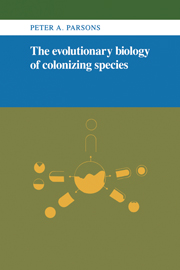Crossref Citations
This Book has been
cited by the following publications. This list is generated based on data provided by Crossref.
Hoffmann, A. A.
Nielsen, K. M.
and
Parsons, P. A.
1983.
Spatial variation of biochemical and ecological phenotypes in Drosophila: Electrophoretic and quantitative variation.
Developmental Genetics,
Vol. 4,
Issue. 4,
p.
439.
Owen, Robin E.
1983.
Sex ratio adjustment in Asobara persimilis (Hymenoptera: braconidae), a parasitoid of Drosophila.
Oecologia,
Vol. 59,
Issue. 2-3,
p.
402.
Spence, G. E.
Hoffmann, A. A.
and
Parsons, P. A.
1984.
Habitat marking: males attracted to residual odors of twoDrosophila species.
Experientia,
Vol. 40,
Issue. 7,
p.
763.
Hoffmann, A A
Parsons, P A
and
Nielsen, K M
1984.
Habitat selection: Olfactory response of Drosophila melanogaster depends on resources.
Heredity,
Vol. 53,
Issue. 1,
p.
139.
Hyytia, P
Capy, P
David, J R
and
Singh, R S
1985.
Enzymatic and quantitative variation in European and African populations of Drosophila simulans.
Heredity,
Vol. 54,
Issue. 2,
p.
209.
Parsons, P A
and
Hoffmann, A A
1985.
Habitat marking: Parallel genetic divergence in two Drosophila species.
Heredity,
Vol. 54,
Issue. 2,
p.
203.
Lodge, D. M.
and
Kelly, P.
1985.
Habitat disturbance and the stability of freshwater gastropod populations.
Oecologia,
Vol. 68,
Issue. 1,
p.
111.
Newman, C. M.
Cohen, J. E.
and
Kipnis, C.
1985.
Neo-darwinian evolution implies punctuated equilibria.
Nature,
Vol. 315,
Issue. 6018,
p.
400.
Marinkovic, D.
and
Ayala, F. J.
1986.
Genetic variation for rate of development in natural populations of Drosophila melanogaster.
Genetica,
Vol. 71,
Issue. 2,
p.
123.
Ehrlich, P. R.
1986.
Ecology of Biological Invasions of North America and Hawaii.
Vol. 58,
Issue. ,
p.
79.
Anderson, John B.
and
McCracken, Gary F.
1986.
Breeding system and population genetic structure in philomycid slugs (Mollusca: Pulmonata).
Biological Journal of the Linnean Society,
Vol. 29,
Issue. 4,
p.
317.
Smith, Charles H.
1986.
A contribution to the geographical interpretation of biological change.
Acta Biotheoretica,
Vol. 35,
Issue. 4,
p.
229.
Bonnemaison, Françoise
and
Jones, David A
1986.
Variation in alien Lotus corniculatus L. 1. Morphological differences between alien and native British plants.
Heredity,
Vol. 56,
Issue. 1,
p.
129.
McKenzie, J A
Fegent, J C
and
Weller, G
1986.
Frequency-dependent selection at the diazinon resistance locus of the Australian sheep blowfly, Lucilia cuprina.
Heredity,
Vol. 56,
Issue. 3,
p.
373.
Kohane, Michael J
and
Parsons, P A
1986.
Environment-dependent fitness differences in Drosophila melanogaster: temperature, domestication and the alcohol dehydrogenase locus.
Heredity,
Vol. 57,
Issue. 3,
p.
289.
Palmer, James O.
and
Dingle, Hugh
1986.
DIRECT AND CORRELATED RESPONSES TO SELECTION AMONG LIFE‐HISTORY TRAITS IN MILKWEED BUGS (
ONCOPELTUS FASCIATUS
)
.
Evolution,
Vol. 40,
Issue. 4,
p.
767.
Smith, P. M.
1986.
Native or introduced? Problems in the taxonomy and plant geography of some widely introduced annual brome-grasses.
Proceedings of the Royal Society of Edinburgh. Section B. Biological Sciences,
Vol. 89,
Issue. ,
p.
273.
Hoffmann, Ary A.
and
Parsons, P. A.
1986.
Inter- and intraspecific variation in the response ofDrosophila melanogaster andD. simulans to larval cues.
Behavior Genetics,
Vol. 16,
Issue. 2,
p.
295.
David Baldwin, J.
and
Dingle, Hugh
1986.
Geographic variation in the effects of temperature on life-history traits in the large milkweed bug Oncopeltus fasciatus.
Oecologia,
Vol. 69,
Issue. 1,
p.
64.
Anderson, P R
and
Oakeshott, J G
1986.
Ethanol tolerance and alcohol dehydrogenase activity in Australian populations of Drosophila simulans.
Heredity,
Vol. 56,
Issue. 2,
p.
185.





